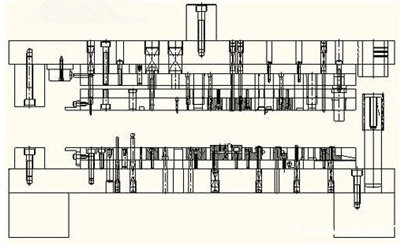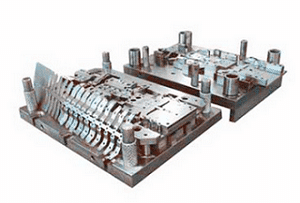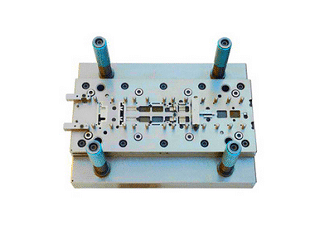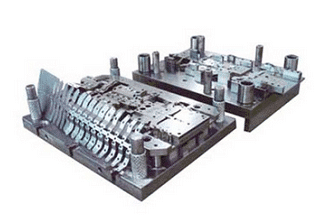Function and Definition of Progressive Die
The English name progressive die refers to a series of stamping dies which are made up of several working stations, each working station completes different processing, each working station is related in sequence, and a series of different stamping processes are completed in one stroke of the punch. Its function is to use the punch and die to exert a certain form and size of force on the sheet metal, so that the material can produce plastic deformation, thereby transforming the hair germ into product parts.
Structure Composition of Progressive Die
1. The progressive die is composed of three parts: the upper die, the lower die and the die sleeve, and is guided by the guide pillar.
2. The upper die has a fixing plate for the upper die, a punch is installed in the plate, and a screw is connected with the upper die.
3. The lower die is a fixed plate of the lower die. The inner plate is filled with core and is composed of another core.
4. In the die sleeve with conical holes, two semi-conical dies are installed, with cavity holes in the middle, and two semi-circular dies have two positioning pins.
5. The unloading part is composed of the ejector rod and the ejector pad. After forming the parts, the upper die is first prized by the special unloading work, and then two semi-conical die are ejected out of the die by the ejector rod, so that the progressive die can be separated and the products can be taken out.

The structure diagram of progressive die&stamping
Product characteristics of progressive die
2. The operation is safe and simple. When progressive die is stamped, the operator does not need to put his hand into the dangerous area of the die. For mass production, automatic feeding mechanism is also adopted, and safety inspection and loading are installed in the die.
1. Progressive die is a multi-process die. In a die, it can include many processes, such as blanking, bending, forming and drawing, and has higher labor productivity than the compound die.
3. Progressive dies have higher strength and longer life because the process is dispersed and need not be centralized in one work station, and there is no “minimum wall thickness” problem of composite dies.
4. Progressive die is easy to automate, including automatic feeding, automatic discharging and automatic riveting.
5. Progressive die workpiece and scrap leak down, so it can be produced by telling press.
6. The use of progressive die can reduce the area of press, workshop, semi-product transportation and warehouse.
7. It is difficult for progressive dies to maintain the consistency of relative positions of inner and outer shapes. The reason is that the inner and outer shapes are punched out one by one, and each stamping will be worse. However, parts with high relative position accuracy of inner and outer shapes may not necessarily have such requirements for all contours, but may only be part of them. In this case, the contour can be rushed out at the same position in the morning to ensure the requirements of the parts.
Advantages of multi-position progressive die
1. Multi-position progressive die is a multi-process die. Within a single die, it can include many processes such as blanking, bending, forming and drawing. It has higher labor productivity than compound die and can also produce quite complex stamping parts.
2. The multi-position progressive die is safe to operate because no man can enter dangerous area.
3. Multi-position progressive die is easy to automate, that is, it is easy to realize automatic feeding, automatic discharging and automatic lamination.
4. Multi-position progressive die can be produced by high-speed press, because workpieces and scraps can leak down directly.
5. The use of multi-position progressive die can reduce the press and the transportation of semi-finished products. Workshop area and warehouse area can be greatly reduced.

Structural characteristics of progressive die
1. The die consists of upper die, lower die and die sleeve, and is guided by guide pillar.
2. The upper die is provided with a fixing plate of the upper die, a punch is installed inside the fixing plate of the upper die, and a screw is connected with the upper template.
3. In the die sleeve with conical holes, two semi-conical dies are installed, with cavity holes in the middle, and two semi-circular dies have two positioning pins.
4. The lower die is composed of a fixed plate of the lower die with a core and another core.
5. The unloading part is composed of the ejector rod and the ejector pad. After the parts are formed, the upper die is first prized by the special unloading work, and then two semi-conical concave dies are ejected out of the die by the ejector rod, so that the progressive die can be separated and the products can be taken out.
The forming process of progressive die
The forming principle of progressive die can be divided into three stages.
1. In the preparation stage, after weighing the plastic powder, it is first poured into the feeding room and heated to a plastic state.
2. In the pressure stage, when the pressing column moves downward on the worktable of the hydraulic press, it enters the feeding room to apply pressure on the molten plastics, and injects into the die cavity at high speed through the casting system of the die, and ensures the heat preservation and hardening for a certain period of time.
3. In the unloading stage, after the opening of the mould, the special unloading mechanism is used to eject the plastic parts, and the cavity, the charging chamber and the runner are cleaned up to prepare for the next stroke of extrusion.

The manufacturing cycle and cost of progressive die
1. Manufacturing cycle of progressive die
The manufacturing cycle of progressive die reflects the technical level and organization management level of die production. When making the mould, we should try to shorten the manufacturing cycle of the mould. By means of computer aided die design and NC machine tool processing technology, the manufacturing cycle of die can be shortened by more than 60%.
2. Progressive Die Manufacturing Cost
The lower the cost of progressive die, the higher the level of die technology. This requires that in the manufacturing of progressive die, in addition to reasonable selection of die materials, but also strive to reduce processing hours and save costs.
3. Precision of progressive die
The precision of progressive die can be divided into the precision required by parts and the precision needed to exert the efficiency of die, such as the parallelism, verticality of plane and the precision of guiding fit. Its processing accuracy is limited by the processing method, equipment and its own accuracy. Generally speaking, the die accuracy mainly refers to the dimensional accuracy of the convex and concave die and the line cavity.

Manufacturing conditions of multi-position progressive die
1. The parts should be stereotyped products, and the batch should be large enough to produce not less than 80,000 pieces per month. Otherwise, the economic benefit will be poor.
2. The accuracy of the parts is moderate, generally greater than IT10. In recent years, with the development of die processing technology, the manufacturing accuracy of multi-position progressive die has been improved significantly, which has also improved the parts, some of which have reached IT8 level.
3. Parts are not suitable for single-process die processing, such as parts with unusually complex shape, which require multiple stamping to complete the shape and size requirements of the parts. If the single-process die can not locate and stamp, the multi-position progressive die is used for continuous stamping.
4. Special parts that are not suitable for compound die processing, such as some special shaped parts, such as lead frame of integrated circuit, stator and rotor piece of micro motor, can not be designed and manufactured with compound die, but can be completed with multi-position progressive die.
5. The shape and size of the workpiece are suitable. When the material thickness of the workpiece is greater than 5 mm and the shape size is larger than 250 mm, the progressive die is not suitable. The material thickness of the general workpiece is 0.2 mm to 4 mm.
6. The length and thickness of stamping materials are suitable, the materials are too short and the production efficiency is low; the materials are too thin, the feeding direction and positioning are difficult; the materials are too thick to be aligned, and the materials are too thick, which are generally shorter and not suitable for automatic feeding.
7. Material should be rigid, otherwise it is not conducive to automatic feeding.
8. The total size and stamping force of the die are suitable for the size of the press and must be matched with the relevant parameters of the press.









